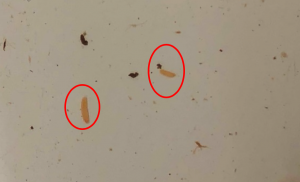
Bryan Jensen, Dept. of Entomology and Division of Extension
A new species of midge has been found in a single NW Wisconsin soybean field. Note, this is not the soybean gall midge (SGM) I have written about earlier but a different species that is very similar in appearance but not considered an economic pest.
This new species is Karshomyia caulicol (Gagne’). I am not sure what the common name will eventually be, but people are referring to is as the white mold gall midge (WGM). As best as we know right now, it does not cause white mold, nor does it predispose a plant to white mold. Likely, it is feeding on decaying plant tissue.
WGM larvae are very similar in appearance SGM larvae which are an economic pest in parts of NE, ND, IA, MN and MO. By the way, SGM’s geographic range has increased during the 2019 growing season but not yet found in Wisconsin. The larvae of both species are small, and most individuals have an orange coloration with varying degrees of color intensity. What you will find useful to differential between the two species will not be the larvae themselves but rather when, where and how they are feeding.
SGM can damage a wide range of plants from the very early vegetative stages (V3) to late reproductive soybeans. However, the majority (if not all) the damage is at or near the soil line. A blackened epidermis is often found at the feeding site. Above ground plant symptoms range from unthrifty to dead plants. Often, individual plants will have brittle stems that may break at the soil line. WGM feeding has been found primarily at the end of the growing season. Feeding sites are usually above ground and can be associated with previous tissue damage. SGM damage is usually more severe at the field edge. WGM may be found throughout the entire field.
Please understand what we know is very limited at this point and likely will change. We certainly will be getting more information out later. In many respects, I am glad it is October. It will give all of us time to sort out what is happening, organize some thoughts and prepare for 2020.
Many thanks to Ryan Bates, Pioneer, for finding and submitting the WGM sample. We all appreciate your help.
